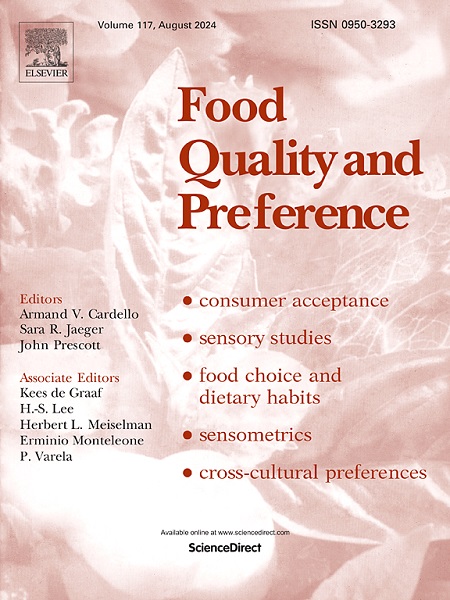消费者对植物性替代品相对于他们直接模仿的食物的看法
IF 4.9
1区 农林科学
Q1 FOOD SCIENCE & TECHNOLOGY
引用次数: 0
摘要
近年来,随着人们对可持续替代品的兴趣日益浓厚,外观和味道与动物源性产品相似的植物性替代品(PBAs)得到了迅速发展。然而,pha面临着满足消费者期望和模仿动物源性产品感官特征的挑战。因此,消费者通常将多氯联苯视为一个单独的类别,而不是动物来源的替代品。本研究的目的是描述消费者如何看待多氯联苯(肉类和乳制品),并将其与他们模仿的动物源性产品进行比较。共有271名成年人完成了一份在线问卷,在问卷中,他们观看了食品图像(PBA、动物源性和对照产品),报告了预期的味道、购买意愿,并使用check-all- thatapply认可了描述符。对影响PBA感知的个人相关因素也进行了评估。PBAs在预期口味和购买意愿上的评分明显较低。对应分析证实,人们认为PBAs与广告产品截然不同,并且PBAs与非自然、环保、现代、冒险、昂贵和平淡等术语相关,而动物源性产品在很大程度上与人们认为的健康分开。一项惩罚提升分析显示,加工过的、不自然的和平淡的是低PBA购买意愿的主要驱动因素。此外,参与者对食品行业的信任(积极)和食品技术新恐惧症(消极)预测了PBA的接受度。总之,这项研究证实了味觉是PBA采用的障碍,同时也确定了不自然和对食品技术的恐惧是重要的挑战。除了追求口味的改善,PBA开发商应该考虑解决这些产品的不自然和加工感知的策略。本文章由计算机程序翻译,如有差异,请以英文原文为准。
Consumers' perceptions of plant-based alternatives relative to the foods they directly imitate
Plant-based alternatives (PBAs) that look and taste like animal-derived products have developed rapidly in recent years in response to growing interest in sustainable alternatives. However, PBAs face challenges meeting consumer expectations and mimicking the sensory profile of animal-derived products. Thus, consumers generally view PBAs as a separate category rather than animal-derived alternatives. The objective of this study was to characterize how consumers perceive PBAs (meat and dairy) and compare them to the animal-derived products they imitate. A total of 271 adults completed an online questionnaire, where they viewed food images (PBA, animal-derived and control products), reported expected tastiness, purchase intention, and endorsed descriptors using check-all-that-apply. Person-related factors influencing PBA perception were also assessed. PBAs were rated significantly lower in expected tastiness and purchase intention. Correspondence analysis confirmed that PBAs were perceived as distinct from their AD counterparts, and that PBAs were associated with the terms unnatural, eco-friendly, modern, adventurous, expensive, and bland, while animal-derived products largely separated by perceived healthiness. A penalty-lift analysis revealed that processed, unnatural, and bland were the top drivers of low PBA purchase intention. Furthermore, participants' trust in the food industry (positively) and food technology neophobia (negatively) predicted PBA acceptance. Together, this study confirms perceived taste as a PBA adoption barrier while also identifying unnaturalness and fear of food technology as important challenges. In addition to pursuing taste improvements, PBA developers should consider strategies to address the unnatural and processed perception of these products.
求助全文
通过发布文献求助,成功后即可免费获取论文全文。
去求助
来源期刊

Food Quality and Preference
工程技术-食品科技
CiteScore
10.40
自引率
15.10%
发文量
263
审稿时长
38 days
期刊介绍:
Food Quality and Preference is a journal devoted to sensory, consumer and behavioural research in food and non-food products. It publishes original research, critical reviews, and short communications in sensory and consumer science, and sensometrics. In addition, the journal publishes special invited issues on important timely topics and from relevant conferences. These are aimed at bridging the gap between research and application, bringing together authors and readers in consumer and market research, sensory science, sensometrics and sensory evaluation, nutrition and food choice, as well as food research, product development and sensory quality assurance. Submissions to Food Quality and Preference are limited to papers that include some form of human measurement; papers that are limited to physical/chemical measures or the routine application of sensory, consumer or econometric analysis will not be considered unless they specifically make a novel scientific contribution in line with the journal''s coverage as outlined below.
 求助内容:
求助内容: 应助结果提醒方式:
应助结果提醒方式:


